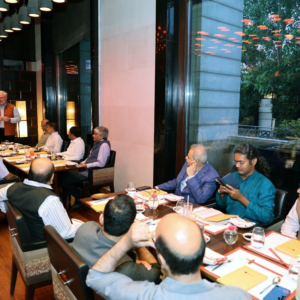Atmanirbhar Bharat is a buzzword which has caught the imagination off not just the entrepreneurial class in India but perhaps of every segment of society. To that extent, the governments approach towards self reliance has made a distinct impact and has appealed to one and all, but it must galvanise all stakeholders on the ground—that is, the industry, the policy makers and the bureaucracy, all of whom need to work in unison. And most importantly, the Indian consumer, whose pride in “Make in India” needs to be rekindled and be channelled towards encouraging the industry—much like how Germany, followed by Japan and later Korea and China, did. What is required now is to create an environment of collaboration rather than confrontation, to convert the re-industrialisation of India to a concrete goal.
The Indian MSME (Micro, Small, and Medium Enterprises) sector contributes to about 30 percent of the Indian economy and over 40 percent of the labour force. Numbering over 63 million enterprises, of which 99.5 percent fall in the micro and small category, it stands second in the world only to China.[1] This is thus an important sector requiring specific focus, especially in the manufacturing space, which by itself constitutes about a third of all enterprises. The Government recognises the need for the manufacturing industries to scale up and hence is creating incentives to bolster it. If we wish to achieve an USD 5 trillion economy in the next few years, the manufacturing sector will have to be upscaled, for which our policies should provide appropriate incentives.
Unfortunately, despite the fast pace of economic reforms that have taken place over the last six years, India is still saddled with a humungous quantity of restrictive laws which shackle economic growth. A whole host of regulatory mechanisms are akin to a millstone around the neck of the entrepreneur, which drags the industry down. Certain reforms, like the implementation of the Goods and Services Tax (GST), have come as a blessing, as in one stroke, the industry was freed from the yoke of the provision of laws such as excise, sales tax, octroi, Local Body Tax (LBT) etc., which were hindering every decision and transaction of business. But much more needs to be done, especially in terms of policy interventions. A study of the copper industry makes an interesting case for greater policy interventions to achieve the Atmanirbharta goals.
Case Study: Copper Industry
India has a copper demand of about 1 mtpa, of which 25% comes from scrap, mainly through the unorganised industry with weak/inadequate environmental and quality standards. Of the balance 0.75 mtpa demand, indigenous copper ore production serves about 5% of this requirement (owned by the PSU, Hindustan Copper) and the remainder has to be imported. Capacities available with both Hindalco and Vedanta are adequate to serve India’s entire demand for smelting & refining of copper. However, we need policy reforms to ensure India remains competitive in this field. This sadly is lacking.
India has FTAs with only a few countries from where the ore comes at 0% duty and the remainder comes from countries where duty levied is 2.5% (for copper, with a price of USD 8000-10,000/MT, the margin for a processor is only ~4% – rest is made by the mine/ore supplier). Roughly, India imports more than half of its ore in concentrate form at 0% duty and the balance by paying 2.5% duty
As India moves to e-vehicles, increased electrification, urbanisation and renewables, the demand for copper is expected to rise to 2 mtpa by 2030. Imports for additional copper ore will be from countries where we pay 2.5% duty, which means that about three quarters of India’s copper ore requirements will be sourced from countries where we need to pay duty. At the same time, India has FTAs with Japan, ASEAN and some other countries, and imports refined copper products from them at 0 % duty. Both Japan and ASEAN however, import copper ore mostly from FTA countries where duty is 0 %. In addition, almost 70% of India’s imports of refined copper, is now from FTA countries where duty is 0%.
This makes the Indian smelting and refining industry for copper uncompetitive with imported refined copper. As a result, Indian manufacturers using refined copper find it cheaper to import the product. This differential in pricing structures is a disincentives to the Indian corporate to invest upstream in smelting/refining capacity in India. To build these capabilities and attain self reliance upstream for this critical metal, Indian policy makers need to look ahead and make policies which incentivise the growth of indigenous capability. Without policy boosts, we will be unable to achieve the Prime Minister’s vision of an Atmanirbhar Bharat.
Case Study: Enabling Manufacturing- The Mittelstand Experience
The ‘Mittelstand’ commonly refers to small and medium-sized enterprises in German-speaking countries, especially in Germany, Austria and Switzerland. These firms are usually defined as enterprises with annual revenues of up to 50 million Euro and a maximum of 500 employees. It would be instructive to see how they achieved world leadership in their expertise areas. Post-World War II, the political leadership, bureaucracy, academia, and entrepreneurs were united by a common purpose of gaining leadership in technology and manufacturing—and that created the miracle. Japan and China followed suit as did developing nations like Korea and Taiwan. Two points stand out in the growth stories of these countries; one, manufacturing was enabled, not shackled; and two, growth was fuelled by the rapid scaling of the small industries into medium ones.[2] In contrast, in India, there was an antipathy to the development of and creation of wealth. This had much to do with the mindsets of the ruling establishment, both at the political and administrative level, which viewed wealth creation as an undesirable element in society, and so imposed regulations that controlled the growth of the manufacturing sector. This thwarted the efforts of our entrepreneurs, whose energies were diverted towards fighting the system, rather than in creating productive value. The government departments were in opposition to, rather than in support of, the Indian entrepreneur, which kept India down for the first half century or so after independence. A socialist mindset glorified poverty and looked at wealth with disdain. The political and bureaucratic class prospered at the expense of the common Indian who remained steeped in poverty. Private enterprise and initiative were all but killed, but crony capitalism grew by leaps and bound.
Since 2014, there has been a concerted effort to change things around, but a lot remains to be done, especially in terms of sensitising the bureaucracy and changing mindsets from exercising control and thwarting growth, to becoming facilitators for the India growth story. India still has a long way to go in this regard.
The Advantage of Scaling
The Mittelstand experience showed the advantage of scaling. Today, the larger corporates in India provide employment to millions of people across the country. The Tata Group and L&T, employ between them, over one million people. Add to this the employment provided by Infosys, Mahindra and Mahindra, Reliance Industries, Wipro, HCL, the Aditya Birla group and a host of private banks, and we come to realise the tremendous contribution of the larger corporate houses to the India growth story.[3] Yet, we continue to rave and rant at these powerhouses of development, rather than seeking to create an environment where the number of large corporate houses can double in a decade. We need a mindset change where the private sector is respected, instead of the other way around. This is where the jobs come from. This is what will create wealth for India. Moreover, the MSME’s too must be encouraged to grow. Scale is a virtue which must be cultivated, not an evil which is to be exorcised. Today, many of the MSMEs which started about 20 years ago, operate more as one-man enterprises, and their business model is floundering.[4] Imagine, if just a million of these enterprises had been enabled and encouraged to upscale to 50-500 employees, based on the Mittelstand model! This would have put India on the world map as a leading industrialised nation, eliminated poverty and unemployment and also reduced many of the social problems that India faces today.
Conclusion
India’s future does not lie in socialist policies which makes beggars out of Indians. We need empowering policies which create wealth and jobs, and which enable each and every Indian to stand on her or his own feet and not depend on handouts for sustenance. That is the India which will be truly Atmanirbhar. And that India can be created through a National Consciousness, to work together for a common cause.
Author Brief Bio:
Maj Gen Dhruv C Katoch is Editor, India Foundation Journal and Director, India Foundation.
References:
[1] https://www.livemint.com/news/india/msmes-the-growth-engines-of-the-indian-economy-11597923225239.html
[2] Samir Kaji, The Future of the Indian MSME and the Manufacturing Sector, India Foundation Journal, Vol II, Issue No 2, March April 2021, available at https://indiafoundation.in/wp-content/uploads/2021/02/March-April-2021-India-Foundation-Journal-1.pdf
[3] Employment stats are available at https://www.statista.com/topics/6583/employment-in-india/#topicHeader__wrapper
[4] Samir Kaji, Note 2.




